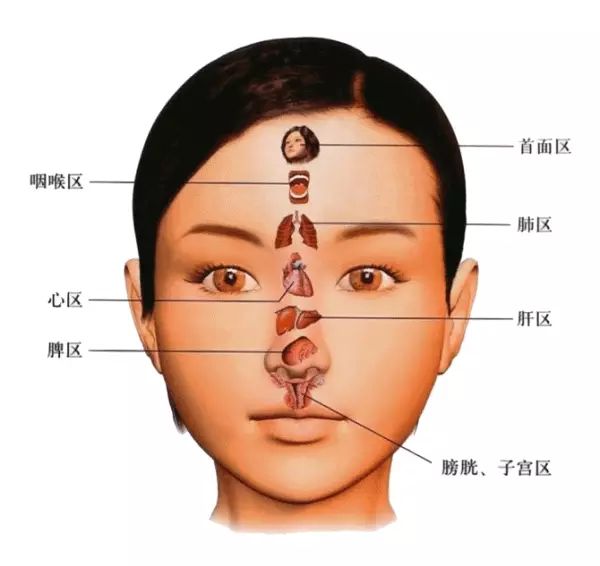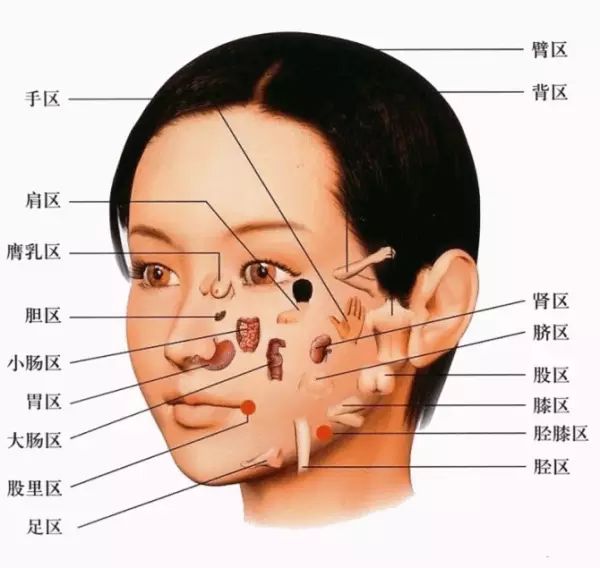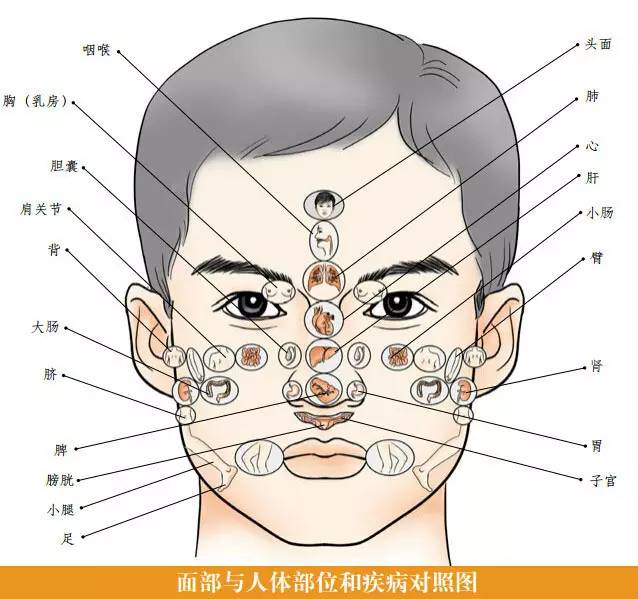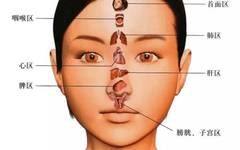
Facial Diagnosis is a part of the essence of Traditional Chinese Medicine (TCM) theory developed over thousands of years, and is one of the four diagnostic methods in TCM: observation, listening, inquiry, and palpation. A healthy person’s face should be clean, with a rosy and lustrous complexion. Newborns typically have clean faces; however, as time passes and various factors such as air, water, food additives, environmental pollution, genetic changes, and mental stress affect health, symptoms gradually appear on the face.
Check health through facial color
1. Yellow: indicates issues with the spleen and stomach, and the digestive system;
2. White: indicates issues with the lungs and respiratory system;
3. Red: indicates issues with the cardiovascular system;
4. Blue: indicates issues with the liver, gallbladder, and immune system;
5. Black: indicates issues with the kidneys and bladder.



“Facial Features”
The face of an infant is clean, and only after they are weaned and start eating solid food do the functions of the heart, liver, spleen, stomach, kidneys, and other organs begin to manifest. As they grow older, various conditions appear on the face, such as acne, blemishes, scars, and wrinkles; typically, adolescents show acne, middle-aged individuals show wrinkles, and the elderly show blemishes.
1. Moles and spots on the face: indicate congenital functional deficiencies of the corresponding organs.
2. Blemishes on the face: indicate chronic diseases formed by long-term depletion in that area (3-5 years to develop).
3. Acne on the face: indicates current inflammatory changes in the corresponding organs (short-term development).
4. Widespread acne and blemishes on the face: indicate endocrine disorders or decreased liver immune function.
“Specific Features”
1. Cardiovascular pressure area: often shows acne, blemishes, and wrinkles.
2. Heart area: horizontal lines (one, two, or several) often indicate heart issues. Nasal lines often indicate insufficient blood supply.
3. Brain area: vertical lines (between the inner corners of the eyebrows, or two or three lines) indicate poor cardiovascular health. A red glabella indicates thick blood lipids, often associated with hypertension.
4. Liver area: shows crow’s feet and blemishes.
5. Gallbladder area: appears bluish.
6. Spleen and stomach area: shows abnormal colors (or a red nose tip) often indicating disharmony of the spleen and stomach.
7. Lung area: appears dark and sunken, indicating poor lung function.
8. Kidney area: appears dark, indicating kidney deficiency. Red bumps indicate lower back pain and general soreness; sunken areas on the cheeks indicate kidney deficiency, and small ears indicate kidney weakness.
9. Bladder area: appears dark and dull, with acne; indicates bladder issues.
10. Large and small intestine areas: show blemishes and “dark spots” indicating poor liver function.
11. Reproductive area: shows abnormal colors, often bluish, indicating endocrine disorders.
12. Chest and breast area: shows dark colors, with one side corresponding to the other.
“Facial Diagnosis”
Facial diagnosis is mainly divided into twelve parts:
namely, “heart, brain, liver, gallbladder, spleen, lung, kidney, bladder, large intestine, small intestine, reproductive, chest and breast.”
Heart
Cardiovascular pressure reflex area: located on the forehead from 1/3 to the hairline (the hairline circle).
1. If acne appears here, or if the forehead color differs, it indicates that the person has significant psychological stress.
2. If there are blemishes here, it indicates heart disease (e.g., myocardial insufficiency).
3. If there are moles or spots here, it indicates congenital insufficiency of heart function.
Heart reflex area: located at the bridge of the nose between the inner corners of the eyes.
4. If horizontal lines appear here or are prominent, it indicates arrhythmia or poor heart condition.
5. If deep horizontal lines appear, and there are also deep vertical lines (grooves) on the tongue, it may indicate serious heart disease.
6. Individuals with heart issues often have red blood vessels on their faces, resembling many small insects crawling on them, indicating poor blood circulation.
Facial Diagnosis Analysis
Individuals with heart issues often have cheerful expressions, always smiling, making them appear pleasant. However, this smile may be constant regardless of the situation. They tend to prefer bitter foods, such as bitter melon and bitter herbs, as their bodies require bitter substances for balance.
Individuals with heart issues often have a red complexion, but not a healthy red; it is a purplish-red.
Brain
Brain reflex area: located between the eyebrows.
1. If vertical lines appear here, and this area is red, it indicates insufficient blood supply to the heart and brain, headaches, neurasthenia, vivid dreams, poor sleep, palpitations, and irritability.
2. If this area is red and shiny, it generally indicates hypertension.

Liver
Liver reflex area: located in the triangular area from the middle of the eyebrows to the outer ends, and the middle section of the nose is also a liver area.
1. The liver governs the eyes: individuals with poor liver and gallbladder function often have eye issues, with yellowish and cloudy sclera, resembling nearsightedness or astigmatism, and some may frequently blink due to weak liver function.
2. Individuals with poor liver function may have horizontal or vertical lines on their nails, or may have gray nails. Their tendons may be swollen, with prominent veins, and in TCM, this is referred to as “nails not smooth”; these individuals may experience cramps, which Western medicine attributes to calcium deficiency.
3. Individuals with poor liver and gallbladder function often have a tendency to anger, easily losing their temper over trivial matters.
4. Individuals with poor liver and gallbladder function tend to prefer sour foods, such as hawthorn and sour apricots, and can eat a lot of them.
5. Individuals with poor liver and gallbladder function often have a grayish complexion, lacking luster, and may appear as if they haven’t washed their face.
Pathological Analysis
1. If these two areas appear bluish or have blemishes, it may indicate fatty liver.
2. If these two areas have acne, it indicates excessive liver heat.
3. If there are blemishes at the temples, it indicates weakened liver function.
4. If there are blemishes in the middle section of the nose, it may indicate excessive liver heat, emotional instability, or menopause.
5. If both areas have significant blemishes and the complexion is dull and unattractive, indicating a thin person, it may indicate hepatitis or cirrhosis.
6. If there is a mole in the center of the eyebrows, and the eyeballs are yellow, with a very yellow complexion, it may indicate hepatitis B.
7. Soft, thin, and dull nails with vertical lines that are prone to breakage indicate poor liver function.
8. A face full of freckles may indicate congenital liver function insufficiency.
Gallbladder
Gallbladder reflex area: located on both sides of the middle section of the nose.
1. If this area has red blood vessels, acne, or if the mouth tastes bitter upon waking, it indicates mild inflammation of the gallbladder.
2. If there are blemishes or dark shadows, it may indicate cholecystitis.
3. If this area has vertical wrinkles or shows vertical lines when smiling, it indicates gallbladder issues.
4. If there are moles or spots in this area, it indicates congenital insufficiency of gallbladder function.
5. If you place your right hand under your right rib (where the gallbladder is located), and strike it with your left fist, if it hurts, it indicates cholecystitis;
6. If the pain is severe, it may indicate gallstones. Individuals with gallbladder issues may be overweight.
7. If there are noticeable blemishes or moles under the eyes in the gallbladder area, it may indicate gallstones. Dark circles under the eyes also indicate poor gallbladder function.
Spleen and Stomach
Spleen reflex area: located at the tip of the nose; stomach reflex area: at the wings of the nose, with the two sides being the duodenum area.
1. If the lips are pale, lacking color, dry, prone to cracking, it indicates poor spleen and stomach function.
2. Individuals with poor spleen and stomach function often have loose muscles and lack elasticity.
3. Individuals with poor spleen and stomach function often frown as if deep in thought, even when there is nothing to worry about.
4. Individuals with poor spleen and stomach function often have a yellow complexion; if someone has a yellow face and frequently frowns, they likely have poor spleen and stomach function.
5. A red nose tip, rosacea, red blood vessels on the nose tip, dark spots, and bumps indicate poor spleen and stomach function.
6. If the nose tip is pale and lacks color, especially very white, it indicates spleen deficiency and may lead to anemia. A yellow nose tip also indicates spleen deficiency, which may present with excessive sweating, aversion to wind, fatigue, and lack of appetite.
7. If the nostrils are always dirty, black, and oily, resembling unwashed skin, or if there are bumps, it indicates poor stomach function.
8. If the nostrils are red, it indicates stomach heat, leading to hunger and bad breath. If there are red blood vessels and it is severe, it generally indicates gastritis.
9. If the nostrils are grayish-blue, it indicates stomach cold; when shaking hands, you can feel that person’s fingertips are cold, indicating they may have stomach pain and diarrhea due to wind-cold.
10. If there are blemishes or moles in the spleen area, it may indicate spleen enlargement; if there are blemishes and moles in the stomach area, it may indicate ulcers and other lesions.
Clinical Analysis
Stomach pain before meals generally indicates gastritis.
Stomach pain one to two hours after meals indicates gastric ulcers, with tenderness in the middle or slightly to the left of the abdomen.
Stomach pain two to four hours after meals indicates duodenal ulcers, with pain located between the ribs near the heart, resembling a needle prick; in severe cases, the pain may radiate to the back, with tenderness in the right side of the abdomen.
Individuals with poor appetite tend to prefer sweet foods, as their bodies require sweetness for balance.
Lungs
Lung reflex area: located between the eyebrows and halfway down the forehead, specifically at the glabella.
Individuals with poor lung function often have nasal issues, such as allergic rhinitis, sinusitis, and frequent respiratory infections.
The lungs nourish the skin and hair; individuals with poor lung function often have rough skin, large pores, and dull, brittle hair. Their emotions may be melancholic, often worrying and crying over minor issues.
Individuals with poor lung function tend to prefer spicy foods.
Individuals with poor lung function often have a pale complexion, lacking color.
Facial Diagnosis Analysis
1. If the glabella is red, it indicates recent upper respiratory infections.
2. If the glabella is dark, especially black, it may indicate disease and should prompt a visit to the hospital.
3. If the middle of the forehead is sunken, and the color is dull, bluish, or has blemishes, it indicates lung disease and difficulty breathing.
4. If there are pimples, it indicates recent colds or sore throats.
5. If there are moles or spots on the eyebrows, it indicates pharyngitis, tonsillitis, or chest tightness and shortness of breath, or lung disease.
6. If there is a bulge above the eyebrows, it also indicates lung disease.
Individuals with poor lung function often have poor large intestine elimination function.
Kidneys
Kidney reflex area: located at the intersection of a vertical line from the outer corner of the eye to the middle of the ear, extending down to the chin.
1. If there are bumps or dark spots in this area, it is not due to lack of cleanliness or sun exposure, indicating poor kidney function.
2. If this area has red blood vessels, acne, or blemishes, it indicates kidney deficiency, often accompanied by laziness and soreness in the lower back and legs.
3. If there are large and deep blemishes in this area, it may indicate kidney stones. If there are recent black moles or bumps on the ears, it may indicate kidney stones.
4. If there are moles or bumps in this area, it indicates congenital insufficiency of kidney function, which may also lead to soreness in the lower back, legs, and back.
5. Deep crow’s feet at the corners of the eyes and vertical lines near the ears indicate declining kidney function.
6. The chin is the area of kidney soreness. If there are red spots or bumps in this area, it indicates lower back pain, generally indicating nephritis.
Bladder
Bladder reflex area: located at the sides of the philtrum and the root of the nose.
1. If this area is red, with red blood vessels, acne, or sores, it indicates cystitis, which may present with yellow, frequent urination, and may also cause lower back pain.
2. If there are wrinkles in the bladder area, it may indicate kidney atrophy; red acne indicates inflammation, and later black moles may indicate disease.
Large and Small Intestines
Large intestine reflex area: located below the cheekbone, extending from the eyeball to the outer corner of the eye down to the mouth corner; this area corresponds to the large intestine.
1. If this area has red blood vessels, acne, blemishes, or moles, it indicates poor large intestine elimination function, often leading to dry stools and constipation.
2. If this area has crescent-shaped blemishes, it indicates constipation or hemorrhoids.
3. If the large intestine area is dark red and uneven, it may indicate colitis.
The intersection of the lower part of the nose and the line from the outer corner of the eye is the reflex area for the rectum.
If there are blemishes here, it may indicate hemorrhoids; if this area is red or has white spots, it may indicate the possibility of rectal cancer.
Small Intestine
Small intestine reflex area: located on the inner side of the cheekbone.
Individuals with heart disease generally have poor small intestine function.
1. If this area has red blood vessels, acne, blemishes, or moles, it indicates poor small intestine absorption function, often leading to loose stools.
Reproductive System
Reproductive system reflex area: located around the philtrum and lips.
1. If a woman has moles or spots below her lips, and the kidney reflex area is relatively clean, it indicates a retroverted uterus and lower back pain.
2. If a woman has moles or spots around her lips, and the kidney reflex area is also poor; or if a woman’s lips are bluish, dark, or pale, and the kidney reflex area is also poor, these situations generally indicate sexual coldness.
3. If there are bumps in the philtrum, it generally indicates uterine disease.
4. If a man has moles or spots around his lips, and the kidney reflex area is also poor, it indicates reproductive system issues.
5. If a man has an uneven upper lip with grooves and vertical lines, it indicates male sexual dysfunction.
Chest and Breast
Chest and breast reflex area: located at the slope of the nose bridge between the eyes.
(1) If there are moles and blemishes in the breast area, it may indicate breast hyperplasia and tumors.
As people age, kidney deficiency and kidney failure can lead to ear problems, such as tinnitus. Kidney deficiency can also lead to bladder, reproductive system, and gonadal diseases.
Any skeletal issues can often be traced back to kidney problems; for example, osteoporosis, bone hyperplasia, herniated discs, and arthritis in the elderly are all caused by weakened kidney function.
Individuals with poor kidney function often experience fear and anxiety. They may have a constant sense of fear, and sudden noises or movements can startle them. Their dietary preference is for salty foods, with a particularly strong taste.
1. If the eyes suddenly become blurry, the corners are dry, and vision is unclear. This is a precursor to liver dysfunction. If you press around the liver, there will be a feeling of swelling. In addition to seeking timely medical attention, it is also important to maintain eye hygiene and avoid excessive eye strain, as improper use of the eyes can also affect liver health.
2. If the ears constantly buzz and sounds are unclear. This is a signal of gradual kidney function decline, sometimes accompanied by foot pain, lower back pain, and frequent urination. Those who work too hard should pay attention to balancing work and rest, avoiding excessive fatigue, and reducing alcohol and spicy food intake.
3. If the sense of smell is dull, with frequent coughing and sometimes even difficulty breathing. This indicates gradual lung dysfunction. Patients should first pay attention to their diet, quit smoking or control their smoking, and avoid being around heavy smokers. They should eat more fresh fruits and vegetables and strengthen physical exercise to prevent lung complications.
4. If the lips feel numb, appetite decreases, and the body becomes increasingly thin. This indicates gradual pancreatic dysfunction, mainly due to dietary imbalances and irregular eating habits. When the pancreas is not functioning well, it affects the stomach, leading to noticeably dry and cracked lips, numbness, and lack of taste. In addition to adjusting the diet, it is also important to avoid eating cold and greasy foods.
.
5. If the sense of taste is dull, unable to taste flavors, accompanied by palpitations, vivid dreams, and insomnia. This indicates damage to heart function. This is often due to overwork; when the mouth feels dry, the tongue coating is thick, and flavors cannot be tasted, it is especially important to be vigilant to prevent heart disease.

Disclaimer: This article is reproduced from the internet and published materials. If there is any infringement, please contact us for removal. The various prescriptions and remedies mentioned are for informational sharing only and do not constitute medical advice, recommendations, or guidance. Please use them under the guidance of a physician; this platform does not bear any responsibility for any consequences arising from this!
Click to support the wisdom of Traditional Chinese Medicine!

